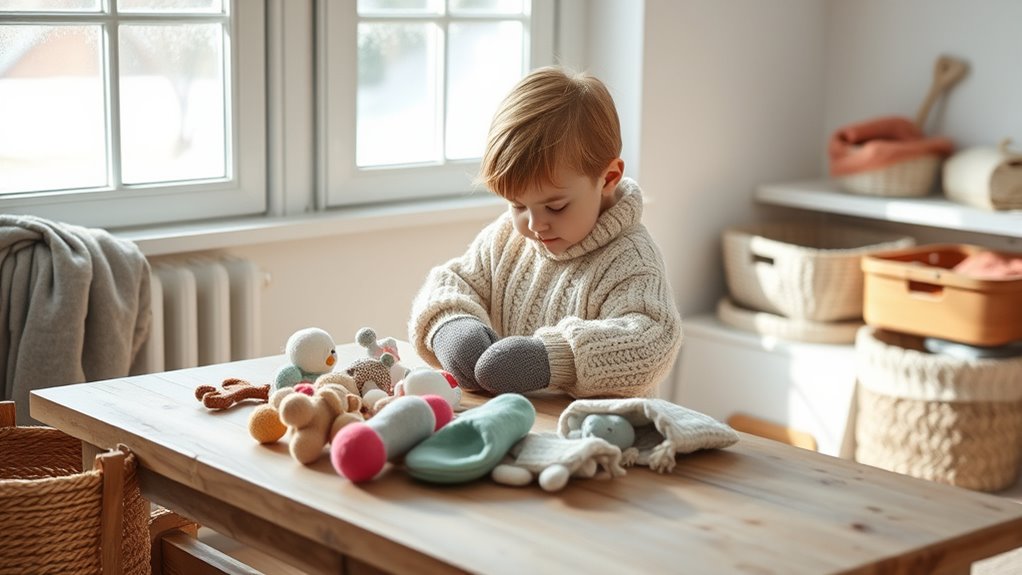To teach kids to embrace winter minimalism and declutter, involve them in sorting seasonal clothing and decorations, emphasizing what truly brings them joy. Label storage spaces and create designated areas for what they choose to keep. Encourage gratitude for possessions and explain how less clutter creates a calmer home. Using winter’s slower pace, you can cultivate habits of organized living and mindful appreciation. Keep exploring these strategies to help your child develop lifelong skills for a simpler, more intentional life.
Key Takeaways
- Involve children in sorting and donating winter clothes to promote sharing and appreciation for essentials.
- Use holiday decoration decluttering to teach intentionality and help children select meaningful items.
- Label storage bins and create designated spaces to develop organizational habits and a tidy environment.
- Emphasize gratitude for possessions kept, fostering mindful attachment and reducing unnecessary clutter.
- Leverage winter’s slower pace to establish decluttering routines that encourage minimalism and mental clarity.

Winter offers the perfect opportunity to teach kids the value of minimalism and decluttering. As the season changes, it’s natural to accumulate items like a seasonal wardrobe filled with bulky sweaters, jackets, and boots, as well as holiday decorations that come out once a year. Instead of letting these items pile up or become overwhelming, this is your chance to guide your kids toward understanding the benefits of keeping only what they truly need and love. By doing so, you help them develop skills that will serve them well beyond winter, fostering a mindset of simplicity and appreciation.
Start by involving your children in sorting their seasonal wardrobe. Explain that winter clothing, while necessary, doesn’t need to be excessive. Together, go through their sweaters, hats, gloves, and jackets, and identify which pieces they wear regularly and which ones they’ve outgrown or no longer fit. Encourage them to donate or pass on items that are still in good condition but aren’t used anymore. This process not only reduces clutter but also teaches them about sharing and generosity. Plus, when they see their wardrobe more organized, they’ll find it easier to get dressed each morning, making winter mornings less stressful.
Similarly, holiday decorations are often a source of clutter once the festivities are over. Use this time to review decorations with your kids. Ask them which items they genuinely love and want to keep, and which ones can be stored away or donated. Explain that keeping only the decorations that bring joy helps maintain a tidy home and makes setup and takedown easier in subsequent years. This activity also introduces the idea of intentionality—being mindful about what we choose to keep around us. As you pack away the decorations, involve your children in labeling boxes and creating designated spaces, reinforcing organizational skills and the value of order.
Throughout this process, emphasize the idea that decluttering isn’t about throwing everything away but about making space for what truly matters. Celebrate their choices and encourage gratitude for the items they decide to keep. As they see the positive effects of decluttering—such as more room to play and a calmer environment—they’ll become more receptive to adopting minimalism as a regular practice. Winter’s slow pace makes it an ideal time to instill these habits, helping your kids understand that less can be more and that living with fewer possessions can lead to a more peaceful, focused life. Additionally, teaching children about space and organization can help them develop lifelong habits that promote a tidy and mindful lifestyle.
Frequently Asked Questions
How Can I Motivate My Kids to Declutter Willingly?
You can motivate your kids to declutter willingly by using motivational techniques like setting fun challenges or offering small rewards. Age-appropriate strategies, such as sorting toys into bins or creating a “keep, donate, toss” game, make the process engaging. Encourage their independence by letting them decide what to keep, and praise their efforts to boost confidence. This approach helps them see decluttering as a positive and manageable activity.
What Are Fun Activities to Teach Minimalism During Winter?
You can make minimalism fun with winter activities like creating cozy winter crafts using only natural or recycled materials. Organize snowy scavenger hunts to encourage kids to appreciate simplicity and nature. These activities keep them engaged while subtly teaching the value of decluttering. Plus, they foster creativity and mindfulness during the colder months, making minimalism an enjoyable and memorable part of winter adventures.
How Do I Handle Sentimental Items My Child Wants to Keep?
When your child wants to keep sentimental items, you need to acknowledge their sentimental attachment, understand their emotional clutter, and set gentle boundaries. Encourage them to select a few meaningful keepsakes, and suggest creative ways to preserve memories—like photos or stories—rather than holding onto everything. By validating their feelings and guiding them toward mindful choices, you help them develop healthy habits while respecting their emotional ties.
What Age Is Best to Start Teaching Kids About Decluttering?
You should start teaching kids about decluttering at an age when they can understand simple concepts, typically around 3 to 5 years old. An early start helps them develop good habits and appreciation for minimalism. Keep it age-appropriate by involving them in small decisions, like choosing toys to donate. Consistency and patience make the process easier, and over time, they’ll learn to value decluttering as a normal part of life.
How Can I Balance Minimalism With Kids’ Holiday Gift-Giving?
You can balance minimalism with kids’ holiday gift-giving by setting clear gift giving boundaries early on. Encourage thoughtful gifts over quantity, focusing on meaningful presents that align with your values. Teach kids to appreciate experiences or handmade items, which help reduce holiday clutter. By involving them in choosing or making gifts, you foster gratitude and *guarantee* the holiday season remains joyful without overwhelming your home with unnecessary clutter.
Conclusion
As you help your kids embrace winter minimalism, imagine a cozy room, free of clutter, where each item sparkles like freshly fallen snow. With fewer belongings, they’ll find more space to breathe, play, and dream aloud. Embracing simplicity this season transforms your home into a peaceful winter wonderland, where each moment feels lighter and brighter. Together, you create a warm, clutter-free haven that invites joy and calm amidst the chilly days ahead.









